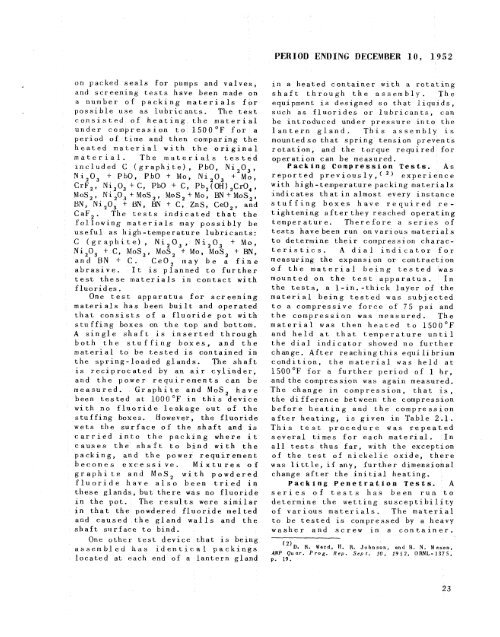the Molten Salt Energy Technologies Web Site
the Molten Salt Energy Technologies Web Site
the Molten Salt Energy Technologies Web Site
You also want an ePaper? Increase the reach of your titles
YUMPU automatically turns print PDFs into web optimized ePapers that Google loves.
on packed seals for pumps and valves,<br />
and screenin8 t,ests have been made on<br />
a number of packing materials for<br />
possible use as. lubricants. The test<br />
consisted of heating <strong>the</strong> material<br />
under compression to 1500°F for a<br />
period of time and <strong>the</strong>n comparing <strong>the</strong><br />
heated material with <strong>the</strong> original<br />
material. The materials tested<br />
included C (graphite), PbO, Ni,O,,<br />
Ni,O, -t- PbO, PbO -t Mo, Ni,O, + MQ,<br />
CrF,, Ni,O, + C, PbO -t C, Pb,(OH),CrO, I<br />
wloS2, Ni 203 + MoS,, MoS, + Mo, RN + MoSz,<br />
BN, Ni,O, + BN, 8N -t- C, ZnS, CeO,, and<br />
CaF,. The tests indicated that <strong>the</strong><br />
following materials may possibly be<br />
useful as high-temperature lubricants:<br />
C (graphite), Ni,O,, Ni,O, + Mo,<br />
Ni,O, + C, FiIoS,, MoS, f Mo, MoSz + BN,<br />
and BN + C. CeO, [nay be a fine<br />
abrasive. It is planned to iur<strong>the</strong>r<br />
test <strong>the</strong>se materials in contact with<br />
fluorides.<br />
One test apparatus for screening<br />
materials has been built and operated<br />
that consists of a fluoride pot with<br />
stuffing boxes on <strong>the</strong> top and bottom.<br />
A single shaft is inserted through<br />
both <strong>the</strong> stuffing boxes, and <strong>the</strong><br />
material to be tested is contained in<br />
<strong>the</strong> spring-loaded glands. The shaft<br />
is reciprocated by an air cylinder,<br />
and <strong>the</strong> power requirements can be<br />
measured. Graphite and MoS, have<br />
been tested at 1000CF in this device<br />
with no fluoride leakage out of <strong>the</strong><br />
stuffing boxes. However, <strong>the</strong> fluoride<br />
wets <strong>the</strong> surface of <strong>the</strong> shaft and is<br />
carried into <strong>the</strong> packing where it<br />
causes <strong>the</strong> shaft to bind with <strong>the</strong><br />
packing, and <strong>the</strong> power requirement<br />
becomes excessive. Mixtures of<br />
graphite and MoS2 with powdered<br />
fluoride have also been tried in<br />
<strong>the</strong>se glands, but; <strong>the</strong>re was no fluoride<br />
in <strong>the</strong> pot, The results were similar<br />
in that <strong>the</strong> powdered fluoride melted<br />
and caused <strong>the</strong> gland walls and <strong>the</strong><br />
shaft surface to bind.<br />
One o<strong>the</strong>r t,est device that is being<br />
assembled has identical packings<br />
located at, each end oE a lantern gland<br />
PERIOD ENDING DECEMBER 18, 1952<br />
in a heated container with a rotating<br />
shaft t,hrough <strong>the</strong> assembly. The<br />
equipment is designed so that liquids,<br />
such as fluorides or lubricants, can<br />
be introduced under pressure into <strong>the</strong><br />
lantern gland. This assembly is<br />
mountedso that spring tension prevents<br />
rotation, and <strong>the</strong> torque required for<br />
operation can be measured.<br />
Packing Compression Tests. As<br />
reported previously,(2) experience<br />
with high-temperature packing materials<br />
indicates that in almost every instance<br />
stuffing boxes have required re-<br />
tightening after <strong>the</strong>y reached operating<br />
temperature. Therefore a series of<br />
tests have been run on various materials<br />
to determine <strong>the</strong>ir compression charac-<br />
teristics. A dial indicator for<br />
measuring <strong>the</strong> expansion or contract,ion<br />
of <strong>the</strong> material being tested was<br />
mounted on <strong>the</strong> test apparatus. In<br />
<strong>the</strong> tests, a 1-in.-thick layer of <strong>the</strong><br />
material being tested was subjected<br />
to a compressive force of 75 psi arid<br />
<strong>the</strong> cornpression was measured. The<br />
material was <strong>the</strong>n heated to 1500'F<br />
and held at that temperature until<br />
<strong>the</strong> dial indicator showed no fur<strong>the</strong>r<br />
change. After reaching this equi li brium<br />
condition, <strong>the</strong> material was held at<br />
1500'F for a fur<strong>the</strong>r period of 1 hr,<br />
and <strong>the</strong> compression was again measured.<br />
The change in compression, that is,<br />
<strong>the</strong> difference between <strong>the</strong> compression<br />
before heating and <strong>the</strong> compression<br />
after heating, is given in Table 2.1.<br />
This test procedure was repeated<br />
several times for each material. In<br />
all tests thus far, with <strong>the</strong> exception<br />
of <strong>the</strong> test of nickelic oxide, <strong>the</strong>re<br />
was little, if any, fur<strong>the</strong>r dimensional<br />
change after <strong>the</strong> initial heating.<br />
Pack i n g P en e t r at io II Te s t s. A<br />
series of tests has been run to<br />
determine <strong>the</strong> wetting susceptibility<br />
of various materials. The material<br />
to be tested is compressed by a heavy<br />
washer and screw in a container.<br />
('ID. R. Herd, H. R. Johnson, end R. N. Mason,<br />
ANI' Quar. Prog. Rep. Sept. 10. 1952. OWL-1375,<br />
p. 19.<br />
23



![Review of Molten Salt Reactor Physics Calculations [Disc 2]](https://img.yumpu.com/21979492/1/190x247/review-of-molten-salt-reactor-physics-calculations-disc-2.jpg?quality=85)












